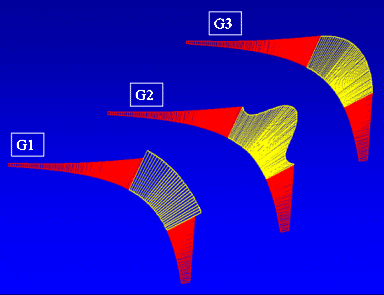Continuity describes the behavior of surfaces and curves at their segment boundaries. The two types of continuity usually dealt with in NX are geometric continuity, denoted Gn, where n is some integer, and mathematical continuity, denoted Cn. Within NX these can be loosely defined.
|
Gn continuity |
Gn indicates the true degree of continuity between two geometric objects. For example, G0 means the two objects are connected, or are position continuous; G1 means they are smoothly connected up to one differentiation, or are tangency continuous. G2 means they are smoothly connected by up to two differentiations, or are curvature continuous; G3 means they are smoothly connected by up to three differentiations, etc. Gn continuities are representation (parameterization) independent. The curvature combs shown in the figure below illustrate these differences.
|
|
Cn continuity |
Cn indicates the degree of continuity between two segments of a B-curve or a B-surface in the Non Uniform Rational B-spline (NURB) representation. Generically, C0 means the two segments are G0 connected. C1 means they are G1 connected; etc. But, C0 does not mean the two segments are just G0 connected -- they could actually be G1 or G2 connected, and so on. |
The key point is that Gn is for real physical continuity, while Cn is one mathematical representation of it, which may not be faithful. Since NURB is an industry standard for freeform geometry, NX uses it. But we always try to have Cn represent the same degree of continuity as Gn, to avoid cases where a curve is G1, but has C0 junction, etc.
Quoting from the ICAD Surface Designer Reference manual: "C0 continuity implies that a common point exists between two adjacent segments (i.e., the segments are touching). C1 implies that there is a common point and the first derivatives of the polynomials (that is, the tangent vectors) are the same. C2 implies that the first and second derivatives are the same. Geometric continuity is less strict than mathematical continuity. G0 and C0 are equivalent, that is, the segments are positionally continuous. G1 implies that the tangent vectors are equal in direction, but not magnitude. G2 implies the curvature is the same, but the second derivatives are not."
